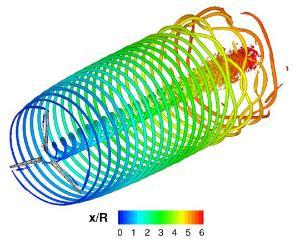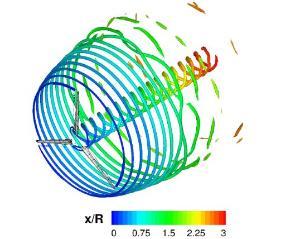Wind Turbine CFD
Accurate prediction of the wind turbine wake is important for the performance analysis of the turbine as well as the optimal positioning of wind turbines within tightly-spaced wind farms. In this work CFD is used to explore the breakdown of the wake downstream of the blades and assess the capability of CFD in predicting the correct physical mechanism of the breakdown.
Method
The solver has so far been validated for several cases including the NREL Annex XX experiments as well as the pressure and PIV data of the MEXICO project.
Recent Results
The wake is resolved on a fine mesh able to capture the vortices up to 8 radii downstream the blades. At a wind speed of 15m/s, the main frequency is the blade rotation (21. 4Hz) and is present in the CFD signals for up to 4 radii downstream the rotor plane, where the vortex cores fall on a perfect spiral. Between 4 and 5 radii downstream, a sinusoidal behaviour is observed, due to a higher frequency content, which indicates the onset of instabilities. This instability results in vortex pairing, and can be observed in the vorticity contours.


Contact
G. Barakos - Professor, George.Barakos@glasgow.ac.uk
R. Steijl - Senior Lecturer, Rene.Steijl@glasgow.ac.uk
M Carrion - Dr, Marina.Carrion@Glasgow.ac.uk
Publications
- Carrion, M., Woodgate, M., Steijl, R., and Barakos, G. (2013) Implementation of all-Mach Roe-type schemes in fully implicit CFD solvers - demonstration for wind turbine flows. International Journal for Numerical Methods in Fluids, pp. 693-728. (doi:10.1002/fld.3818)
- Carrion, M., Steijl, R., Woodgate, M., Barakos, G., Munduate, X., and Gomez-Iradi, S. (2015) Computational fluid dynamics analysis of the wake behind the MEXICO rotor in axial flow conditions. Wind Energy, 18(6), pp. 1023-1045. (doi:10.1002/we.1745)
- Carrion, M., Woodgate, M., Steijl, R., Barakos, G. N., Gomez-Iradi, S., and Munduate, X. (2015) Understanding wind-turbine wake breakdown using computational fluid dynamics. AIAA Journal, 53(3), pp. 588-602. (doi:10.2514/1.J053196)
- Carrion, M., Steijl, R., Woodgate, M., Barakos, G. N., Munduate, X., and Gomez-Iradi, S. (2014) Aeroelastic analysis of wind turbines using a tightly coupled CFD–CSD method. Journal of Fluids and Structures, 50, pp. 392-415. (doi:10.1016/j.jfluidstructs.2014.06.029)








